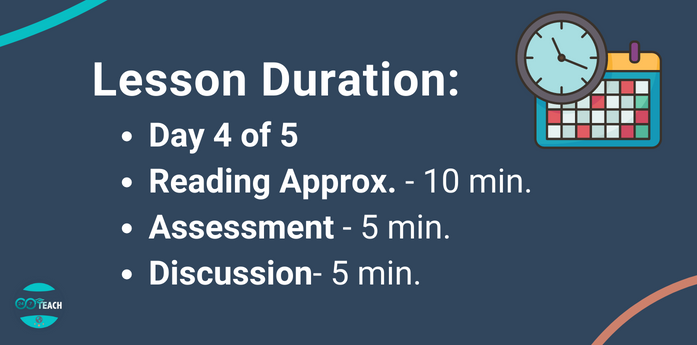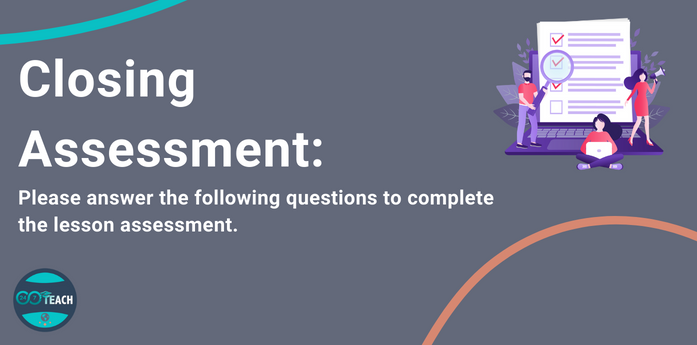Lesson 4: The Instructional Design Process
Prefer to listen to this lesson? Click below:
Workshop Scenario:
Please think of yourself in the following scenario as you complete this workshop.
You’ve recently applied for an instructional design position with 24/7 Teach and are going through the interview process. The organization likes you and is moving forward in the interview process.
- Before an offer can be made, the company will need you to design a project, a short lesson that can teach people about the instructional design process and its importance, to evaluate your skill level.
- To complete the project, you will need to go through the entire instructional design process from beginning to end, complete your design, and be able to explain your design process in detail.
Your objective for today is to learn the different steps of the instructional design process.

Important Questions to Answer While Reading:
In order to be successful in this lesson, you must be able to answer these important questions.

- What step within the Instructional Design process is the most important?
- In what instructional design stage is your instructional approach determined?
- How does a prototype support an instructional designer and the instructional design process?
Lesson 4: Instructional Design Process
Instructional Design Process: A Step-By-Step Guide
Every organization has its own process for developing online training courses. Some organizations follow a linear process, while others prefer an iterative one. Some organizations prefer to work on the entire training at once, while others prefer to identify small segments within the training and develop them concurrently through collaboration.
There are several factors that influence an organization’s decision to follow a certain process—training requirements, client expectations, tools, development time, flexibility, complexity, budget, etc.

No matter which approach an organization follows, there are a few steps that remain mandatory in every Instructional Design process. Understanding the purpose of each mandatory step will help you successfully achieve the desired output at every step, irrespective of your approach! Let’s look at a few of them.
Step 1: Analyze Requirements:
The Learning analysis is the most important step of the Instructional Design process. When analyzing, never limit your efforts to understanding just the training and business needs. Stretch your analysis to include four other areas as well: Audience, Content, Technology, and Expectations.
- Business And Training Need
Business needs differ from training needs. A business need helps you understand the holistic need for training. The training need, however, helps you understand how the training will help to meet the business needs.
- Learners’ Profile
Analyze learners’ profiles based on their roles, responsibilities, professional experience, educational qualifications, skill sets, age, technical proficiency, ethnicity, and geographical location. In addition, gather information about their existing knowledge about the topic, challenges faced, and most importantly, find out the learning gap that this training is expected to fill up. Also, find out their learning needs and/or preferred mode of training.
- Content

Instructional Designers are not Subject Matter Experts (SMEs), but a thorough understanding of the content is a must. Read the source content multiple times to understand its key message. Note down your questions and forward them to an SME for clarification. In addition, ask for examples, scenarios, and case studies that can be used to support the content and/or assess the learner.
- Technology
The eLearning industry is rapidly evolving with new technology and new tools. Hence, it is critical to understand the technology that the client organization and the learners are most familiar with. Ask questions to understand the client’s preferred development tool, prevalent Learning Management System (LMS), available devices to launch the course, etc.
- Branding
Branding is what gives an organization its unique identity. Hence, understand the writing (tone, tense, voice, vocabulary) and graphical standards (images, fonts, characters, icons) that are followed in their organization. Also, ask the client to share samples of previously designed courses, if possible for reference.
Step 2: Identify Learning Objectives
Once you analyze the requirements, frame the learning objectives. Learning objectives help you distinguish between the ‘good-to-know’ and ‘must-know’ content and determine the emphasis every piece of information needs in training. Also, your assessments should be drafted mapping to these learning objectives.
Step 3: Develop Design
Design development is a process in itself. First, segregate the content into small chunks of information and organize them in a logical sequence. Once the topic list is ready, determine an instructional approach for your course (story-based approach, problem-based approach, video-based approach, game-based approach, etc.) in line with the scope defined during the analysis. Insert engagement points into your Instructional Design by adding an attention-grabbing activity, motivational videos, reflection questions, interactivity, scenarios and examples, a summarizing activity, etc.
Step 4: Create A Storyboard

A storyboard is a visual document that lets you organize your content with visuals and present a flow for the topics. Identify the type of content you are dealing with. It could be facts, principles, processes, classifications, or relationships. Present the content for each page using relevant text, images, icons, characters, development notes, etc.
Step 5: Develop Prototype
Develop a functional prototype before starting the complete development. Identify four to five unique pages of different types and develop them using the approved design strategy and the client’s branding guidelines. A prototype will help your client visualize how the storyboard will be transformed into a functional module.
Step 6: Develop Training
Once the storyboard and prototype are signed off, initiate the development of training that will be finally uploaded on the LMS. This will include developing visuals, interactivities, knowledge checks, and assessments per the approved storyboard, along with recording and integrating the voice-over of a professional artist.
Step 7: Deliver Training
LMS is a platform for hosting eLearning courses for an organization. Ensure your course is compatible with the LMS on which the training will be hosted. Also, understand the different features of the client’s LMS, like tracking learners’ progress and assessment performance, generating course completion reports, and adding pre-training and post-training resources.
Step 8: Evaluate Impact

The final step is to evaluate the impact of training. Typically, the evaluation can be done at two levels – at learner’s level to analyze if the learners found the training to be engaging and useful, and at organization’s level to evaluate if the training has positively impacted the business and helped achieve the business need.
Every project is different and so are its stakeholders and their expectations. Take the liberty to customize these steps and create your own step list for the Instructional Design process.

Closing Assessment:
Please respond to the lesson email with answers to the following questions, and one of our instructional design mentors will respond with feedback.
- What step within the Instructional Design process is the most important?
- In what instructional design stage is your instructional approach determined?
- How does a prototype support an instructional designer and the instructional design process?
Advance your understanding:

1. Please answer the following question in the comment section below and interact with learners from around the world.
- What aspects of the instructional design process would motivate you to be an instructional designer?
2. Please read and reply to other learners’ answers in the forum by stating if you agree or disagree with their answers and why. Your replies should offer new substantiated ideas or thoughtful questions.

